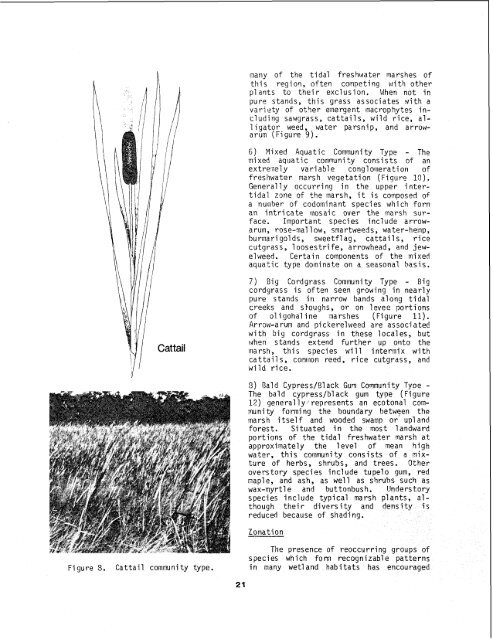The Ecology of Tidal Freshwater Marshes of the - USGS National ...
The Ecology of Tidal Freshwater Marshes of the - USGS National ...
The Ecology of Tidal Freshwater Marshes of the - USGS National ...
You also want an ePaper? Increase the reach of your titles
YUMPU automatically turns print PDFs into web optimized ePapers that Google loves.
many <strong>of</strong> <strong>the</strong> tidal freshwater marshes <strong>of</strong>this region, <strong>of</strong>ten competing with o<strong>the</strong>rplants to <strong>the</strong>ir exclusion. When not inpure stands, this grass associates with avariety <strong>of</strong> ot'ier emergent macrophytos includingsawgrass, cattails, wild rice, alli yator weed, water parsnip, and arrowarum(Figure 9).6) Mixed Aquatic Community Type - <strong>The</strong>mixed aquatic community consists <strong>of</strong> anextrenely variable conglomeration <strong>of</strong>freshwater marsh vegetation (Figure 10).Generally occurring in <strong>the</strong> upper intertidalzone <strong>of</strong> <strong>the</strong> marsh, it is comuosed <strong>of</strong>a number <strong>of</strong> codominarlt species which forman intricate mosaic over <strong>the</strong> narsh surface.Important species include arrowarum,rose-ma1 1 ow, smart\.reecls, water-hemp,burrnarigolds, sweetflag, cattails, ricecutqrass, 1 oosestri fey arrowhead, and jewelweed.Certain comoonents <strong>of</strong> <strong>the</strong> mixedaquatic type dominate on a seasonal basis.7) Big Cordgrass Comrnunity Type - Bigcordyrass is <strong>of</strong>ten seen growing in nearlypure stands in narrow bands along tidalcreeks and sloughs, or on levee portions<strong>of</strong> 01 igohal ine garshes (Figure 11).Arrow-arum and pickerelweed are associatedwith big cordgrass in <strong>the</strong>se locales, butvdhon stands extend fur<strong>the</strong>r up onto <strong>the</strong>marsh, this species will inter:nix withca ttai 1 s, cornr?ion reed, rice cutgrass, andwild rice.3) Bald Cypress/Black GUT Commuqity Ty~e<strong>The</strong> bald cypress/black gum type (Figure12) generally represents an ecotonal communityforming <strong>the</strong> boundary between <strong>the</strong>marsh itself and wooded swam or up1 andforest. Situated in <strong>the</strong> most landwardportions <strong>of</strong> tile tidal freshwater marsh atapproximately <strong>the</strong> level <strong>of</strong> mean highwater, this comvunity consists <strong>of</strong> a mixture<strong>of</strong> herbs, shrubs, and trees. O<strong>the</strong>roverstory species include tupelo gum, redmaple, and ash, as well as shrubs such aswax-myrtl e and buttonbush. Understoryspecies include typical tnarsh plants, a7-tilough <strong>the</strong>ir diversity and density isreduced because <strong>of</strong> shading.Zonation-Figure 3. Cattail community type.<strong>The</strong> presence <strong>of</strong> reoccurring groups <strong>of</strong>species which fom recognizable patternsin many wet1 and habitats has encouraged

















